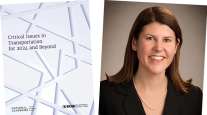Senior Reporter
FMCSA Declares ‘Call to Action’ to Counter Rise in Traffic Deaths

This story appears in the Jan. 16 print edition of Transport Topics.
WASHINGTON — A top Federal Motor Carrier Safety Administration official issued a “call to action” last week, citing preliminary statistics showing that fatalities in crashes involving large trucks and buses increased 7% to 8% in 2016.
“These aren’t just numbers,” said Daphne Jefferson, FMCSA deputy administrator. “These are husbands and wives, children, mothers and fathers.”
Jefferson was presenting “Federal Motor Carrier Safety Administration Safety Activities and Priorities” on Jan. 10 during the annual meeting of the Transportation Research Board here.
She said there were 4,337 fatalities in crashes involving large trucks and buses in 2015 — a 1.4% increase over 2014. She did not detail the preliminary numbers for 2016.
“While the number 4,337 is lower than it was 10 years past, the recent trends are ticking up. Those numbers are way too high, and we need to continue to focus on bringing those numbers down.”
Also speaking at TRB, Jack Van Steenburg, FMCSA chief safety officer, said agency officials and the industry need to focus on prevention.
Van Steenburg said that not only did truck-involved crash fatalities increase in 2015, but overall highway crash fatalities increased 7.2%. The last time the single-year overall percentage jumped as high was in 1966, he said.
“Folks, we need to do more,” he said. “We have to prevent these fatal crashes.”
Truck drivers failing to wear their seat belts are a major contributor to the high numbers, Van Steenburg said. As a result, the agency is calling on law enforcement, primarily through grants to the top 10 states with high fatality rates, to write more citations and step up traffic stops in addition to conducting roadside inspections.
“We need to slow the truck drivers down,” he said. “If a truck driver or bus driver is speeding, write him a ticket.”
Van Steenburg said that law enforcement traditionally is reluctant, even intimidated, to pull a truck or bus over to the roadside.
“We encourage law enforcement to conduct traffic enforcement,” he added. “Our research shows that traffic enforcement tied with inspections saves a lot more lives than just inspections.”
Van Steenburg said he is also very concerned over too many fatal accidents involving pedestrians and bicyclists, trucks in construction zones as well as a continuing high number of truck occupant fatalities.
With the number of 2015 FAST Act mandates aimed at FMCSA, the agency had a “very busy” 2016, Jefferson said. In total, it posted 22 rulemakings, including final rules that mandated the use of electronic logging devices, created an entry-level driver training regimen and established a drug and alcohol clearinghouse requirement, she said.
The agency also has consolidated its primary grant programs, reducing their number to four from 10, allowing greater flexibility in funding state needs, according to Jefferson.
The agency also is awaiting a driver commuting study and a major study by the National Academy of Sciences taking a sweeping look at the Compliance, Safety, Accountability program, she said.
Robert Miller, director of FMCSA’s office of policy, strategic planning and regulations, said he expects that a final safety fitness determination rule will not be announced until the agency has time to digest the National Academy’s CSA study, anticipated for public release this spring.
He said FMCSA has not yet accumulated a “robust data set” on obstructive sleep apnea and that a rule allowing the use of hair samples for drug testing and a controversial rule on speed limiters are “not imminent.” However, Miller said he expects a Department of Transportation Office of Inspector General study on driver detention to be released soon.
Jefferson said she is looking toward the presidential transition at the end of this week and any new plans for the agency under Elaine Chao.
Chao has so far indicated she has three priorities for the Department of Transportation, Jefferson said.
They include effective enforcement of safety measures, getting the most benefit out of the department’s budget resources and preparing for the future by considering new technologies, Jefferson said.
“Now I can see FMCSA’s name written over all three of those,” she added. “I think we’re on the right track and will continue moving forward in 2017.”




